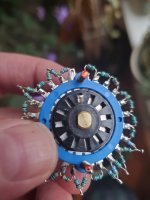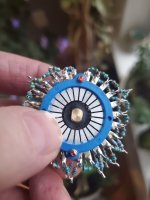Actually I really like the Allo. The switch appears to be the same as the 2 that I ordered from ali so going to be attaching through hole resistors on those.
wish I just purchased the allo now and not the ali switches..
Anyway, have 3 different units coming for comparison
wish I just purchased the allo now and not the ali switches..
Anyway, have 3 different units coming for comparison
Me more or less too...
I just finished a THT ladder attenuator, sheesh it was a lot of finickry stuff. Getting the allo would have been much easier and cheaper, but I needed (wanted) to do it myself.
The switch is similar to the Allo, blue body, with whitish top and bottom. I haven't mounted a knob yet (so I don't know what it will be when in use), but I don't feel confident about the mechanical quality of it. Hard, and not consistent, to turn, some positions click differently than others...
But hey, my first diy-ladder! 😀
I just finished a THT ladder attenuator, sheesh it was a lot of finickry stuff. Getting the allo would have been much easier and cheaper, but I needed (wanted) to do it myself.
The switch is similar to the Allo, blue body, with whitish top and bottom. I haven't mounted a knob yet (so I don't know what it will be when in use), but I don't feel confident about the mechanical quality of it. Hard, and not consistent, to turn, some positions click differently than others...
But hey, my first diy-ladder! 😀
Received the EIZZ attenuator and 6-24 switches from ali.. Really pleased. EIZZ is smooth and high quality with 0.1% tolerance between channels. impressive!
no play in the shaft👍
6-24 switch is pretty fine for the cost!
Thanks
no play in the shaft👍
6-24 switch is pretty fine for the cost!
Thanks
I have a smd 21 step attenuator from eBay, there was a link a couple of posts above, pretty happy with it, but would a attenuator like the Goldpoint make an audible difference? Also going from 21 to 24 steps, will I even notice the finer steps?
I'm planning a 2 switch attenuator. thinking 4x6 ladder connected to 2x12 series.
I'd like to use Elma switches. I contacted them to find out about purchasing direct and possible retailers in Canada.
Any USA of Canada for just the switches?
I'd like to use Elma switches. I contacted them to find out about purchasing direct and possible retailers in Canada.
Any USA of Canada for just the switches?
Elma are not cheap at all. Quality have a price ( they'll stand many life after ours).
Expect between 150/400€ depending of the type used.
Bulk order can lower price a bit but not much.
Try Gearspace if you don't find a retailer ( Elma's are often used on (nice) pro gear so pro knows where to find them).
Maybe ask some members here which are pro and in your country ( Turk182 comes to my mind).
Expect between 150/400€ depending of the type used.
Bulk order can lower price a bit but not much.
Try Gearspace if you don't find a retailer ( Elma's are often used on (nice) pro gear so pro knows where to find them).
Maybe ask some members here which are pro and in your country ( Turk182 comes to my mind).
That one is priced well for a built one, lcsaszar!
I'm set for now for economy builds with EIZZ and home built units with 6-24 switches..
I have a few 2 chassis preamps in the works. PSU chassis powering a preamp/crossover chassis. For this design, 60+ steps is in the plan!
ELMA might to expensive.. I see ali has 4 deck 6 step and 2 deck 12 step but no current stock, exactly what I need
I'm set for now for economy builds with EIZZ and home built units with 6-24 switches..
I have a few 2 chassis preamps in the works. PSU chassis powering a preamp/crossover chassis. For this design, 60+ steps is in the plan!
ELMA might to expensive.. I see ali has 4 deck 6 step and 2 deck 12 step but no current stock, exactly what I need
Slightly OT question, came across a constant impedance step attenuator use & made by Allnic a Korean hi-end audio company,
can someone explain what does it mean ? Trying to wrap my head to understand it's working principle.
Many thanks
can someone explain what does it mean ? Trying to wrap my head to understand it's working principle.
Many thanks
Constant input impedance most probably.
The preceding stage 'see' the same Z whatever the step. But output impedance vary... and why you have to locate them close to next stage ( hopefuly a high input impedance one) or use a buffer stage.
If constant impedance input then it's a series of 'regular' Lpad.
Here is a relay controled example ( sometimes wrongly named R2R), but same principle apply, study schematic and use resistor calculator to define step value ( if you want different attenuation levels (eg -7,5db) it is possible, find an online Lpad calculator) :
https://www.amb.org/audio/delta1/
You are not forced to use a Pic to control relay: either(multiple) on/off switch, either a multi deck stepped rotary could be used.
With on/off switch it is cheap but tedious to operate ( don't expect wife or kids to use them without 'accident').
With multiple rotary switch it's easier to use ( as depicted in a previous post: coarse level (-64/-32/-16/-8/0), fine level ( 0 to -4), nitpicking (-0,1 or -0,5db to -3,9 or -3,5 ).
I use a variant of on/off with buffers ( mandatory in my view but ymmv).
Other 'constant impedance' exist like the one used as 'level brake' between guitar amp and cab to practice at home. Those are constant input/output impedance kind but they are not used at line level because it is 'bridging' transmission line: low ouput z to high input z: we seek to transfer a voltage not a power ( which is the case between amp/cab which is matched transmission line).
There was exception though... AbbeyRoad studios used matched transfer in the 60's...
The preceding stage 'see' the same Z whatever the step. But output impedance vary... and why you have to locate them close to next stage ( hopefuly a high input impedance one) or use a buffer stage.
If constant impedance input then it's a series of 'regular' Lpad.
Here is a relay controled example ( sometimes wrongly named R2R), but same principle apply, study schematic and use resistor calculator to define step value ( if you want different attenuation levels (eg -7,5db) it is possible, find an online Lpad calculator) :
https://www.amb.org/audio/delta1/
You are not forced to use a Pic to control relay: either(multiple) on/off switch, either a multi deck stepped rotary could be used.
With on/off switch it is cheap but tedious to operate ( don't expect wife or kids to use them without 'accident').
With multiple rotary switch it's easier to use ( as depicted in a previous post: coarse level (-64/-32/-16/-8/0), fine level ( 0 to -4), nitpicking (-0,1 or -0,5db to -3,9 or -3,5 ).
I use a variant of on/off with buffers ( mandatory in my view but ymmv).
Other 'constant impedance' exist like the one used as 'level brake' between guitar amp and cab to practice at home. Those are constant input/output impedance kind but they are not used at line level because it is 'bridging' transmission line: low ouput z to high input z: we seek to transfer a voltage not a power ( which is the case between amp/cab which is matched transmission line).
There was exception though... AbbeyRoad studios used matched transfer in the 60's...
Last edited:
Many thanks for the explanation Krivium, have a look at this vid :
its doesn't seem to be constant impedance fo input only.
Many thanks for the explanation Krivium, have a look ....
its doesn't seem to be constant impedance fo input only.
If you want constant in/out to my knowledge there is no escape: it have to be either a T or bridged T ( check the uneeda link).
From what he describe he made a rehostat pot/switch. I don't know if it has constant z but i doubt.
This is tube gear so presumably high input Z. No need other than a Lpad in my view ( if used with 'regular' gear).
From what do you say it's constant i/o?
From the translation there is no clues about this ( he talks distortion of contact point... well yes maybe...have heard people complaining about that for relay too... but given i'm used to do maintenance on very big analog studio desks... this is not something the best manufacturers had concerns about... and old 'vintage' desks are sought after for their 'sound' ( Neve) despite using rotary multi points contactor... SSL and Ams/Neve/Amek/Focusrite used tons of relays too despite being 'kind of pinnacle' of analog technology... )
Last edited:
Well, I built one 23 stepped attenuator. Initially I checked the switch function with a meter on the front deck and assumed the rear deck was fine but after full assembly I discovered an issue with the rear deck. I took it apart and compared it to the second unit I purchased. With the switch set to off position the contact was in one space to the right of where it is in the photo. I used the second unit to see exactly how the contact piece is oriented in the slot. Also, some of the fingers were bent upward and straightened those.
Now testing fine with the ohmmeter with less than 0.5% between decks.. Next step install in DCG3!
Now testing fine with the ohmmeter with less than 0.5% between decks.. Next step install in DCG3!
Attachments
Is anyone running an Elma attenuator with their "Remote Audio Plus" IR controlled motorized unit????
I'm tempted. Opinions first would be welcome!
I'm tempted. Opinions first would be welcome!
Almost. I have the elma „relatt“ relay attenuator, sort of a previous project of them. Very sophisticated, works very good, although the relays, compared to those used in a i-select jig, are very loud.
I use Eizz 24 step AMRS from Aliexpress. Its transparentcy is much better than the standard blue ALPS. Eizz AMRS got the first rate build quality. The step is in log scale and practical.

- Home
- Design & Build
- Parts
- Seeking sources for Stepped Attenuators - Decent to excellent quality with price as a consideration.

